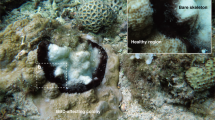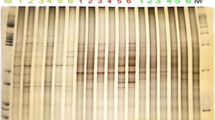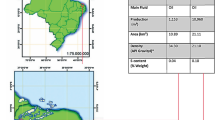Abstract
Factors that facilitate the onset of black band disease (BBD) of corals remain elusive, though anoxic conditions under the complex microbial mat and production of sulfide are implicated in necrosis of underlying coral tissues. This study investigated the diversity and quantitative shifts of sulfate-reducing bacterial (SRB) populations during the onset of BBD using real-time PCR (RT-PCR) and cloning approaches targeting the dissimilatory (bi)sulfite reductase (dsrA) gene. A quantitativePCR (qPCR) assay targeting the 16S rRNA gene also provided an estimate of total bacteria, and allowed the relative percentage of SRB within the lesions to be determined. Three Montipora sp. coral colonies identified with lesions previously termed cyanobacterial patches (CPs) (comprising microbial communities unlike those of BBD lesions), were tagged and followed through time as CP developed into BBD. The dsrA-targeted qPCR detected few copies of the gene in the CP samples (<65 per ng DNA), though copy numbers increased in BBD lesions (>2500 per ng DNA). SRB in CP samples were less than 1% of the bacterial population, though represented up to 7.5% of the BBD population. Clone libraries also demonstrated a shift in the dominant dsrA sequences as lesions shifted from CP into BBD. Results from this study confirm that SRB increase during the onset of BBD, likely increasing sulfide concentrations at the base of the microbial mat and facilitating the pathogenesis of BBD.
Similar content being viewed by others
Log in or create a free account to read this content
Gain free access to this article, as well as selected content from this journal and more on nature.com
or
Accession codes
References
Altschul SF, Madden TL, Schaffer AA, Zhang J, Zhang Z, Miller W et al. (1997). Gapped BLAST and PSI-BLAST: a new generation of protein database search programs. Nucleic Acids Res 25: 3389–3402.
Antonius A . (1973). New observations on coral destruction in reefs. In 10th Meeting of the Association of Island Marine Laboratories of the Caribbean, pp. 3. University of Puerto Rico: Association of Island Marine Laboratories of the Caribbean.
Barneah O, Ben-Dov E, Kramarsky-Winter E, Kushmaro A . (2007). Characterization of black band disease in Red Sea stony corals. Environ Microbiol 9: 1995–2006.
Ben-Dov E, Brenner A, Kushmaro A . (2007). Quantification of sulfate-reducing bacteria in industrial wastewater, by real-time polymerase chain reaction (PCR) using dsrA and apsA genes. Microb Ecol 54: 439–451.
Carlton RG, Richardson LL . (1995). Oxygen and sulfide dynamics in a horizontally migrating cyanobacterial mat: Black band disease of corals. FEMS Microbiol Ecol 18: 155–162.
Cooney RP, Pantos O, Le Tissier MDA, Barer MR, O’Donnell AG, Bythell JC . (2002). Characterization of the bacterial consortium associated with black band disease in coral using molecular microbiological techniques. Environ Microbiol 4: 401–413.
Frias-Lopez J, Klaus JS, Bonheyo GT, Fouke BW . (2004). Bacterial community associated with black band disease in corals. Appl Environ Microbiol 70: 5955–5962.
Frias-Lopez J, Zerkle AL, Bonheyo GT, Fouke BW . (2002). Partitioning of bacterial communities between seawater and healthy, black band diseased, and dead coral surfaces. Appl Environ Microbiol 68: 2214–2228.
Jørgensen BB, Nelson DC . (2004). Sulfide oxidation in marine sediments: geochemistry meets microbiology. In: Amend JP, Edwards K, Lyons TW (eds). Sulfur Biogeochemistry—Past and Present vol. 379. Special paper Geological Society of America, pp 36–81.
Kondo R, Shigematsu K, Butani J . (2008). Rapid enumeration of sulphate-reducing bacteria from aquatic environments using real-time PCR. Plankton Benthos Res 3: 180–183.
Kumar S, Dudley J, Nei M, Tamura K . (2008). MEGA: a biologist-centric software for evolutionary analysis of DNA and protein sequences. Brief Bioinform 9: 299–306.
Leloup J, Loy A, Knab NJ, Borowski C, Wagner M, Jørgensen BB . (2007). Diversity and abundance of sulfate-reducing microorganisms in the sulfate and methane zones of a marine sediment, Black Sea. Environ Microbiol 9: 131–142.
Myers JL, Richardson LL . (2009). Adaptation of cyanobacteria to the sulfide-rich microenvironment of black band disease of coral. FEMS Microbiol Ecol 67: 242–251.
Nadkarni MA, Martin FE, Jacques NA, Hunter N . (2002). Determination of bacterial load by real-time PCR using a broad-range (universal) probe and primers set. Microbiology 148: 257–266.
Ramos-Flores T . (1983). Lower marine fungus associated with black line disease in star corals (Montastraea-annularis, E and S). Biol Bull 165: 429–435.
Richardson LL . (1997). Occurrence of the black band disease cyanobacterium on healthy corals of the Florida Keys. Bulletin of Marine Science 61: 485–490.
Richardson LL . (2004). Black band disease. In: Rosenberg E, Loya Y (eds.). Coral Health and Disease. Springer-Verlag: Berlin, Germany, pp. 325–336.
Richardson LL, Kuta KG . (2003). Ecological physiology of the black band disease cyanobacterium Phormidium corallyticum. FEMS Microbiol Ecol 43: 287–298.
Richardson LL, Kuta KG, Schnell S, Carlton RG . (1997). Ecology of the black band disease microbial consortium. Proceedings of the eighth international coral reef symposium 1: 597–600.
Richardson LL, Miller AW, Broderick E, Kaczmarsky L, Gantar M, Stanic D et al. (2009). Sulfide, microcystin, and the etiology of black band disease. Dis Aquat Org 87: 79–90.
Sato Y, Bourne DG, Willis BL . (2009). Dynamics of seasonal outbreaks of black band disease in an assemblage of Montipora species at Pelorus Island (Great Barrier Reef, Australia). Proc R Soc B: Biol Sci 276: 2795–2803.
Sato Y, Willis BL, Bourne DG . (2010). Successional changes in bacterial communities during the development of black band disease on the reef coral, Montipora hispida. ISME J 4: 203–214.
Schloss PD, Westcott SL, Ryabin T, Hall JR, Hartmann M, Hollister EB et al. (2009). Introducing mothur: open-source, platform-independent, community-supported software for describing and comparing microbial communities. Appl Environ Microbiol 75: 7537–7541.
Stal LJ . (2000). Cyanobacterial mats and stromatolites. In: Whitton BA, Potts M (eds.). The Ecology of Cyanobacteria. Kluwer Academic Publishers: Dordrecht, The Netherlands, pp. 61–120.
Viehman S, Mills DK, Meichel GW, Richardson LL . (2006). Culture and identification of Desulfovibrio spp. from corals infected by black band disease on Dominican and Florida Keys reefs. Dis Aquat Org 69: 119–127.
Wagner M, Roger A, Flax J, Brusseau G, Stahl D . (1998). Phylogeny of dissimilatory reductases supports an early origin of sulfate respiration. J Bacteriol 180: 2975–2982.
Wagner M, Loy A, Klein M, Lee N, Ramsing NB, Stahl DA et al. (2005). Functional marker genes for identification of sulfate-reducing prokaryotes. Methods Enzymol 397: 469–489.
Acknowledgements
The authors thank staff of Orpheus Island Research Station (JCU) for logistic support and field volunteers for their assistance during sampling. Lone Høj (AIMS) is also thanked for helpful comments to improve the paper.
Author information
Authors and Affiliations
Corresponding author
Additional information
Supplementary Information accompanies the paper on The ISME Journal website
Supplementary information
Rights and permissions
About this article
Cite this article
Bourne, D., Muirhead, A. & Sato, Y. Changes in sulfate-reducing bacterial populations during the onset of black band disease. ISME J 5, 559–564 (2011). https://doi.org/10.1038/ismej.2010.143
Received:
Revised:
Accepted:
Published:
Issue date:
DOI: https://doi.org/10.1038/ismej.2010.143
Keywords
This article is cited by
-
Microbial mat compositions and localization patterns explain the virulence of black band disease in corals
npj Biofilms and Microbiomes (2023)
-
The mucosal–luminal interface: an ideal sample to study the mucosa-associated microbiota and the intestinal microbial biogeography
Pediatric Research (2019)
-
Climate-driven shifts in sediment chemistry enhance methane production in northern lakes
Nature Communications (2018)
-
Black Band disease-related (BBD) cyanobacterium from Okinawan corals
Journal of Applied Phycology (2018)
-
Unraveling the microbial processes of black band disease in corals through integrated genomics
Scientific Reports (2017)



